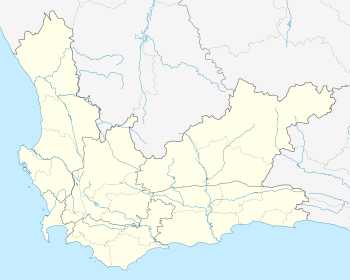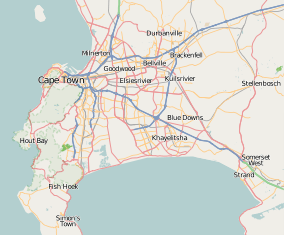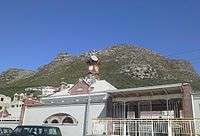Muizenberg
| Muizenberg | |
|---|---|
|
An aerial view of Muizenberg taken from the East. | |
 Muizenberg  Muizenberg  Muizenberg
| |
|
Location within Cape Town  Muizenberg | |
| Coordinates: 34°06.3′S 18°28.3′E / 34.1050°S 18.4717°ECoordinates: 34°06.3′S 18°28.3′E / 34.1050°S 18.4717°E | |
| Country | South Africa |
| Province | Western Cape |
| Municipality | City of Cape Town |
| Established | 1743 |
| Area[1] | |
| • Total | 15.14 km2 (5.85 sq mi) |
| Population (2011)[1] | |
| • Total | 36,857 |
| • Density | 2,400/km2 (6,300/sq mi) |
| Racial makeup (2011)[1] | |
| • Black African | 39.1% |
| • Coloured | 26.2% |
| • Indian/Asian | 1.3% |
| • White | 27.8% |
| • Other | 5.7% |
| First languages (2011)[1] | |
| • English | 44.3% |
| • Afrikaans | 22.8% |
| • Xhosa | 15.3% |
| • Zulu | 1.4% |
| • Other | 16.2% |
| Postal code (street) | 7945 |
| PO box | 7950 |
| Area code | (021) 787/788 |
Muizenberg is a beach-side suburb of Cape Town, South Africa. It is situated where the shore of the Cape Peninsula curves round to the east on the False Bay coast. It is considered to be the birthplace of surfing in South Africa and is currently home to a surfing community, centered on the popular 'Surfer's Corner'.

Historically, the village has several special features, including Het Posthuys (the Post House), Rhodes' Cottage, and the site of the Battle of Muizenberg.


Rhodes' Cottage is a small house on the seafront that Cecil Rhodes bought as a holiday cottage and this was where he died in 1902. The house is preserved as a museum dedicated to Rhodes' life and is open to the public.

Het Posthuys is one of the oldest buildings in South Africa,[2] dating to circa 1742. It was built by the Dutch East India Company (Vereenigde Oost-Indische Compagnie or VOC) as a toll-house to levy a tax on farmers passing by to sell their produce to ships lying in Simon's Bay. One of the early postholders was Sergeant Muys (meaning "mouse"), from whom Muizenberg (formerly Muysenbergh and Muys Zijn Bergh (Muys' mountain) before that) gets its name. After a varied career as a police station, stables, brothel, hotel and private house the building was identified for what it was in the 1980s and restored with funds from Anglo American Corporation. The house is cared for by the Muizenberg Historical Conservation Society and contains a small collection of photos and items of interest relating to early days in Muizenberg. It is open to the public.

The Battle of Muizenberg was a small but significant military affair that began in June 1795 and ended three months later with the (first) British occupation of the Cape. Thus began the period (briefly interrupted from 1804 to 1806) of British control of the Cape, and subsequently much of Southern Africa. The historical remnant of the Battle of Muizenberg is a site on the hillside overlooking False Bay that holds the remains of a defensive fort started by the Dutch in 1795 and expanded by the British from 1796 onwards.

Muizenberg has a fine, long beach that in effect stretches all the way round the top of False Bay to the Strand, a distance of over 20 km. False Bay, known for its population of White Sharks, also has a shark watch service that operates from Muizenberg, signalling alerts when sharks come in proximity of bathers and surfers. Above Muizenberg there is a line of steep cliffs that is very popular as a venue for rock climbing. However, certain parts of the cliff are off-limits to climbers when birds nest on the ledges.
The Zandvlei estuary enters the ocean in Muizenberg. The estuary is one of the most important estuaries for fish spawning on the coastline and is home to the Imperial Yacht Club and Peninsula Canoe Club.
Muizenberg houses one of the False Bay College campuses in the Cinnabar Building, a high-rise apartment tower. The college, a Public Further Education and Training Institution (FET), was established in September 2002 when the South Peninsula College (established 1970) and the Westlake College (established 1954) were merged.[3] Muizenberg is also home to the African Institute for Mathematical Sciences (AIMS), a pan-African centre for education and research in mathematical sciences.
Nearby places of interest
| Wikimedia Commons has media related to Muizenberg. |
| Wikivoyage has a travel guide for Muizenberg. |
References
- 1 2 3 4 "Main Place Muizenberg". Census 2011.
- ↑ ArteFacts
- ↑ Falsebay College
.svg.png)